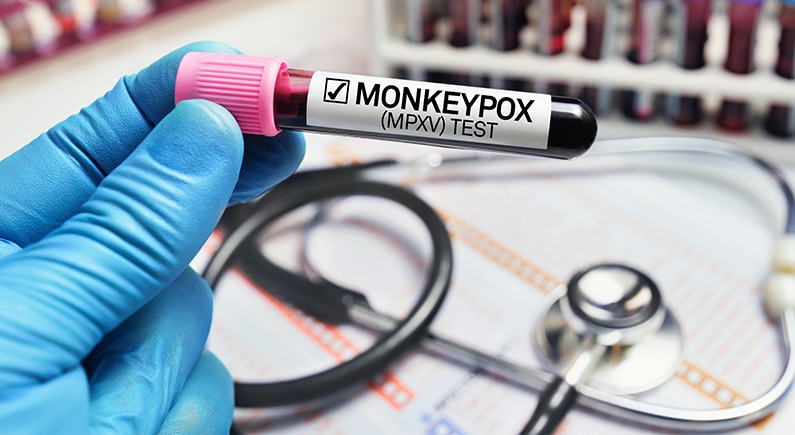
Michael Joe Cini
10th May 2023
Rapid Testing Breakthrough: Detecting Mpox Through Molecular Sensors
The monkeypox virus is spreading rapidly, with vaccines and current therapeutics unable to contain the spread of the virus. Public health researchers have determined that rapid testing is the best solution for mpox containment. To improve the ability of clinicians to detect the monkeypox virus, researchers at Penn State University have developed a selective molecular sensor to detect the virus within minutes.
The breakthrough: Nanoparticles for pathogen detection
Before developing the new technique, PCR (polymerase chain reaction) was the only FDA-approved test for mpox. PCR has several limitations, including complex methods for sample collection, limited access to advanced instrumental facilities, and transportation challenges. “We were interested in developing a sensitive detection method for pathogens generally and also wanted to apply the concept to an emerging pathogen like mpox, because there is a real-world urgency for this rapid nucleic acid test,” Pan stated, concerning the new technology.
Pan and his team published their findings in the February 2023 issue of Advanced Functional Materials in an article titled ‘Nucleotide-Driven Molecular Sensing of Monkeypox Virus Through Hierarchical Self-Assembly of 2D Hafnium Disulphide Nanoplatelets and Gold Nanospheres.’ In the article, the researchers described how they used the hierarchical assemblage of 2D hafnium disulphide nanoplatelets and zero-dimensional spherical gold nanoparticles to create a new multi-functional material. In the presence of the target analyte – in this case, DNA – the self-assembling pattern of the nanoparticles is altered, causing a change in their plasmonic response.
In their work, the researchers found that adding genomic DNA to the nanocomposite surface increased the agglomeration between gold nanoparticles and decreased the π-stacking distance between hafnium disulphide nanoplatelets. This caused a change in the signal produced by the material in the presence of light. According to their findings, the plasmonic response of the spherical gold nanoparticles shifted from about 520 nm towards the red wavelength region after binding with the target molecule.
In choosing the materials for the study, the researchers looked to select a 2D and 0D material that effectively complemented each other in terms of advantages and sensitivity, with graphene oxide, reduced graphene oxide, hafnium disulphide and molybdenum disulphide nanoplatelets, model covalent organic framework (COF) and copper embedded COF (CuCOF) being among the original options. The researchers eventually chose HfS2 and MoS2 nanoplatelets due to the additional binding between them and gold nanoparticles.
To ensure that the platform was specific for MPXV (monkeypox virus) DNA, the researchers developed an optimized suspension, with gold nanoparticles admixed with 3 mg mL-1 of hafnium disulfide nanoplatelets. They then varied the concentration of MPXV genomic DNA added to the suspension mixed with conjugated gold nanospheres. This helped minimise the system’s cross-reactivity with other pathogen-extracted genomic materials. Hence, the system is more sensitive towards detecting MPXV DNA. According to Pan, nanoparticles have been used to observe biological changes – but this was the first time they had been employed to detect an emerging pathogen.
The monkeypox scourge: Rapid testing a needed response
The research into the hafnium disulfide nanoplatelets and gold nanospheres was conducted by a team of researchers led by Dipanjan Pan, Dorothy Foeher Huck & J. Lloyd Huck Chair Professor in Nanomedicine at Penn State University. Dipanjan Pan previously served as a Professor in Radiology, Chemical, Biochemical and Environmental Engineering at the University of Maryland Baltimore. Pan also has experience in bioimaging, having held a position as Assistant Professor at the Beckman Institute in Bioimaging Science and Technology.
Parikshit Moitra, Maria Iftesum, David Skrodzki, Priyanka Paul, Elnaz Sheikh, and Jennifer Lynn Gray were collaborators on this project. Other members of the ten-person team are Ketan Dighe, Zach Sheffield, and Manas Ranjan Gartia. The Centres for Disease Control and Prevention (CDC), the National Science Foundation (NSF), and the Department of Defense Congressionally Directed Medical Research Program funded the project.
The monkeypox virus, which rapidly spread around the world last year, left the world grappling with a significant healthcare problem. The first human mpox disease was identified in the 1970s in DR Congo and has been considered endemic only in West and Central Africa. Since May 2022, the virus has spread to over a hundred countries, causing over 80,000 infections, per CDC reports. It is transmitted mainly by close physical contact and causes symptoms similar to smallpox. Research shows that people can spread mpox before exhibiting symptoms, making early detection a vital tool to mitigate its spread.
“Scientists strive to provide the public with cutting-edge, advanced technologies that enable them to self-diagnose or get rapid testing at the point of care, [which] is what we have done,” stated Pan. His lab is currently testing the technology against a broader panel of pathogens to confirm its applicability for pathogenic detection. After clinical validation, they will work to bring the technology to market.
Rapid testing: A new opportunity for the Mpox response
Led by Dipanjan Pan, Penn State University’s Dorothy Foehr Huck & J. Lloyd Huck Chair Professor in Nanomedicine, the Penn State researchers made a significant breakthrough in developing detection technology for the monkeypox virus, colloquially known as mpox. It is the first such rapid test for mpox, representing a new turn for how clinicians and health workers can improve the response to monkeypox, which has now infiltrated the United States. According to the CDC, about one in three cases of monkeypox globally are concentrated in the US.
“This is a major breakthrough in terms of how we manage the virus, as it is the first rapid test for mpox,” said Pan, the team lead on the research project. Pan’s statements indicate that the rapid testing tech would be valuable for an effective public health response to mpox spread. “It’s also important to note that this new technology can help us to prepare for the next epidemic or even pandemic,” added Pan, also a professor of nuclear engineering and materials science and engineering.
This is of particular use as mpox spread has yet to abate, spreading from Africa into over 100 countries since May 2022. “While current caseloads are relatively low, as the weather warms and people become more active, cases could spike as they did last summer,” said Pan, pointing out that the mpox problem could worsen without rapid solutions. The new technology is based on plasmonics, a technique where electrons in metal nanoparticles interact with light to create a signal that is affected by binding to nucleic acids, such as DNA and RNA. The researchers developed the nanoparticles in this technology from gold, with a thin layer of hafnium disulphide, and the test can provide a result within a few minutes.
Be part of the Med-Tech World Roadshow
Join us in London for an extraordinary evening of networking, knowledge sharing, and groundbreaking advancements in digital health and med-tech. This is an unmissable chance to connect, collaborate, and actively contribute to shaping the future of healthcare.




